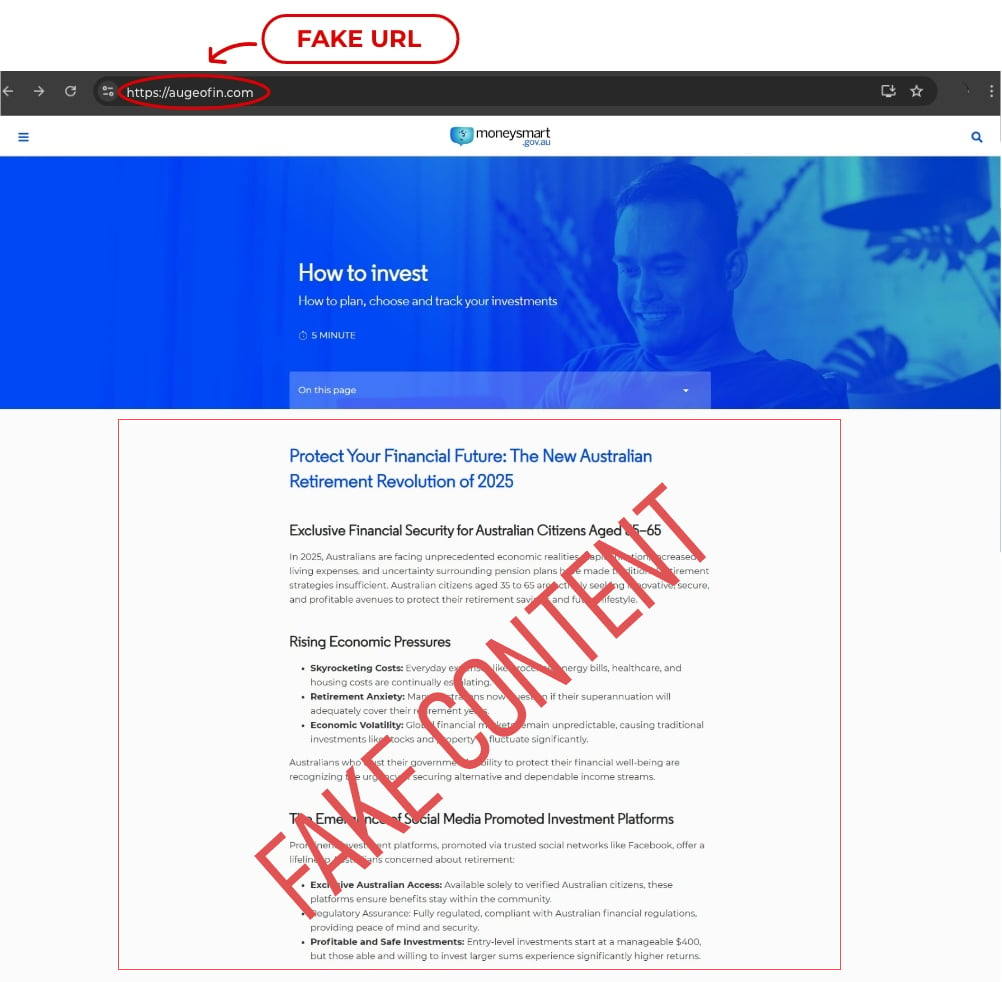Scammers have been impersonating Moneysmart webpages, including How to invest - Moneysmart.gov.au
Key points
- Scammers have been impersonating Moneysmart webpages, including How to invest - Moneysmart.gov.au
- Consumers are being asked to submit their name and email address to learn more about investing and investment options.
- The website looks and feels very similar and may contain links to real Moneysmart pages in an attempt to legitimise them.
- Consumers should take care to ensure they are visiting moneysmart.gov.au each time they engage with the Moneysmart website.
Be alert to scam websites
ASIC has been made aware that its Moneysmart website is being impersonated. The legitimate Moneysmart website address (URL) is moneysmart.gov.au.
The fake websites look similar to the Moneysmart website but contain a different URL that is not moneysmart.gov.au.
The fake websites promote investment options and contain words that create a feeling of urgency to invest, such as talking about the poor state of the economy, the potential of ‘missing out’ and the need to act or invest ‘today’. They often promote big returns of thousands of dollars for an initial small sum of money, for example, $300 or $400 as initial payment.

The legitimate Moneysmart website will never ask consumers to provide personal information with a view to promoting investment options, or contact consumers to propose or offer investment options. Moneysmart will never ask consumers to pay money to enter into an investment option.
ASIC is also aware of fake websites promoting investment options which make false representations about government investment schemes.
If you have been contacted by someone offering investment advice and claiming to be ASIC or Moneysmart, you should hang up the phone report the email and block the number.
Stop, Check, Protect: ASIC’s Moneysmart message to consumers
Fake websites try to trick consumers into handing over their personal information so scammers can contact them and pressure-sell investment options.
If you see a website, social media ad or message promoting an investment option, always remember to stop, check and protect.
- Stop: Ask are you clicking on a link from a legitimate or impersonation website. If the link takes you to a different website, is the new website asking you to provide your personal information. Watch out for websites that promote an investment opportunity with a simple initial payment and claims to be or endorsed by ASIC or Moneysmart.
- Check: If you’re clicking onto Moneysmart from a search engine or a social media ad, check the website URL to confirm that you’re visiting the legitimate domain: moneysmart.gov.au
Look for the:
- Moneysmart – which is the name of our website
- .gov.au - which indicates a government website address
Remember to check the website address again before entering any personal or sensitive information. Consumers should consider whether the information being requested is required and think carefully before handing over any personal information or identification documents.
- Protect yourself and others by reporting websites impersonating ASIC or Moneysmart to Scamwatch with details and/or a screenshot of the suspicious website.
For more information, see how to spot a scam website.
Think you have already been scammed?
If you think you’ve been scammed, take these steps fast:
- Do not send any more money. Block all contact from the scammer.
- Report it to your bank or financial institution. Contact your bank or financial institution and ask them to stop any transactions. If you are not happy with your financial institution’s response you can lodge a complaint with them. If you are not happy with this response, you can make a complaint to the Australian Financial Complaints Authority.
- Report it to Scamwatch to help stop the scammer. Warn your family and friends about the scam.
- Be wary of follow-up scams promising to help get your money back.
- Contact IDCARE, a free government-funded service, which can help to develop a specific response plan if your identity has been compromised. IDCARE will never contact you out of the blue.
- Go to what to do if you’ve been scammed for more detailed steps.